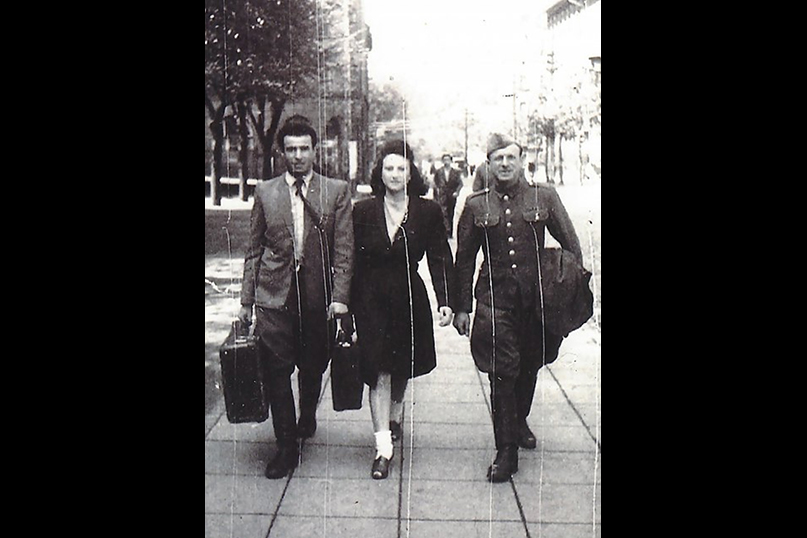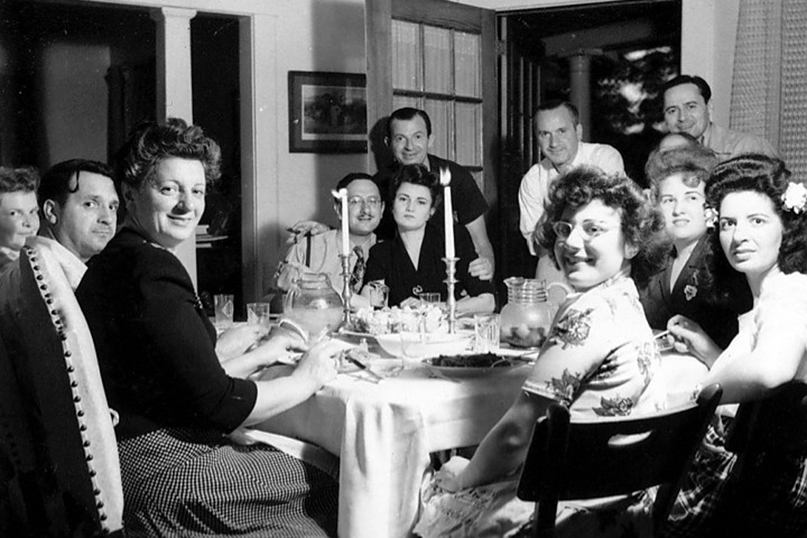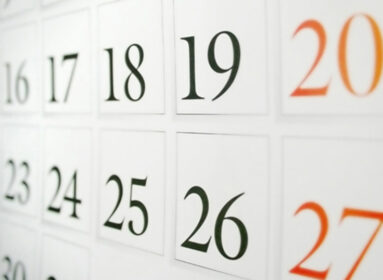
By Brian Slattery
It’s an old photograph, of three people walking hand in hand in hand down the street. All of them are in mid-stride. All of them are looking straight at the camera. One is in a suit, one in a dress, one in a military uniform. They have a story to tell, and what a story it is.
“Abraham (1920-2010) Chana (1926-2020) and Fiszel (1910-1986) Tugentman were the only survivors of their family after WW II,” writes Ghislane Palumbo on an accompanying note. The Tugentmans had lived in Warsaw before the war began. They fled to Russian-occupied Bialystock in 1939. The brothers were drafted into the Russian army. When the Nazis occupied the city they sent Chana to a work camp; everyone else was killed.
“After the war my uncles Abraham and Fiszel checked with the Joint in Warsaw to see who in their family had been listed as survivors, and they found my mother Chana working as a seamstress in Lodz, Poland. They all had married by 1946 and wanted to leave Europe, so they went and signed up through the Joint Distribution Committee, which sent them to the displaced persons camp in Heideheim, Germany. I believe the picture was taken in Munich on their way to the DP camp. In that picture my uncles still had their Russian Post-War boots, and my mother wore a new coat my father had made for her.”
Palumbo’s story is just one among multitudes in “Ancestors,” an engrossing photography exhibit up now through Nov. 7 in two floors of Congregation Beth El–Keser Israel at 85 Harrison St. in Westville.
Curated by BEKI’s art committee, the exhibit — composed of family photographs from congregants, along with accompanying stories about the people in the photographs — commemorates the rich and complex story of the survival and persistence of the Jewish people. Some of the faces in the images belong to those who died in the Holocaust. Others are of those who escaped to the United States. But also, there’s a rabbi who appeared on the cover of Life magazine; cowboys, one of whom was the inspiration for Lonesome Dove; a lawyer who sang in a glee club; a grandfather who emigrated from Poland — or Russia — to become a tailor in Boston.
The exhibit weaves together the harrowing and the mundane, the humor and the hard work, to celebrate life, family, and the strength that can come from connections to the past.
For Cynthia Beth Rubin, a New Haven-based artist who exhibits regularly here and abroad and is a member of BEKI’s art committee, the exhibit is a long time in the making. The idea for an art gallery at BEKI, Rubin said, began with Helen Rosenberg, fellow member of BEKI’s art committee. “She had the idea of using the upper gallery,” Rubin said. When the area a floor below was renovated a few years ago, they made sure it had the lighting needed to be able to use it as a gallery space too. “People were really behind it,” Rubin said.
From the start the art was understood as a way to build community, whether it was to display Judaica that BEKI members owned or to host a number of individual shows by artists from New Haven and beyond. BEKI’s gallery also hosted an exhibition of photographs BEKI members had taken of synagogue buildings across the world — whether they currently housed congregations or had been repurposed for another use (as is the case of the Educational Center for the Arts’s use of the former Mishkan Israel synagogue on the corner of Audubon and Orange Streets).

“Most were international but it could have been in Connecticut or local,” Rubin said. Rubin and fellow artist Bruce Oren put that project together over two years, 2018 and 2019, and “that was hugely successful,” Rubin said.
It opened the door to thinking of other ways to involve many of BEKI’s members, which got the committee thinking about ancestry, and put out the call to BEKI members to share the photographs they had.
“We spent a lot of time making sure that we were not giving a narrow definition of ancestors,” Rubin said. The subjects of the photographs didn’t have to be Jewish, nor did they have to be direct ancestors. “Anything that people felt fit” was allowed, Rubin said. “There were people who wanted to honor ancestors who didn’t survive,” or “people who were hidden children and were the only ones who did survive.”
That broad definition is part of what makes the exhibit so rich. Among the images is a painted family portrait, the ancestors of Tina Rose.
“My grandfather was in the Polish army in WWI, my mom and uncle were not born yet, my aunt Ada is standing (she died as a lawyer getting Jews out of Poland during the Holocaust), my other aunt Clara, sitting, survived and passed away 20 years ago, my uncle survived and passed 15 years ago. My mom and her brother were not born yet. My mom passed 32 years ago,” Rose writes. “My mom and dad found this photo painting at a Bronx street fair after the war in the ‘50’s, my mom had to pay to get it back.”
Rubin started getting pictures from congregants in 2020, just as the pandemic shutdown was settling in. “We started seriously in May” of that year, she said, and “we got so many — twice as much as we thought we would have.” Many of the photographs from congregants were small, so they were scanned, resized, and reprinted, making them visible from a standing distance.
They finished framing in August and installed the photographs at the end of that month, “to keep the idea of community building around the holidays,” Rubin said, even if “we only had a fraction of people show up in person” for services. The images were and are “something that would make people feel like it was their space.”
The resizing emphasized the idiosyncrasies of the photos as physical artifacts — blurred images, sepia coloring, frayed edges. It also brought out details that were harder to see in the smaller originals. That was in part due to Rubin’s scanning work. “There were a few things I went crazy with because, stupidly, I enjoy fixing photographs,” she said with a laugh. But in seeing the images blown up to a larger size, people saw “family resemblances that they never saw before. They’re related in a way they never did before.”
The exhibit sometimes highlights the fragility of our connections to the past. Most families’ living memories don’t go back much farther than a few generations — perhaps to great-grandparents. Those collective memories are further tested by the circumstances in which BEKI congregants’ ancestors arrived in the United States. Many “wanted to leave the old country behind” and start over,” Rubin said. Many left no records. Many people have pictures of ancestors they don’t know.
But sometimes those connections to the past were strengthened, too. Rubin said in her own case, a photograph of her family holding a seder during World War II “gave me an opportunity to put things in a historical context.” She had shared the image during her family’s own virtually held seder this year. “It was this juxtaposition between having a seder during the war and having a seder during the pandemic,” the sense of threads that weaved their way through calamity and upheaval, irrevocably changed but unbroken. “I think everybody has that,” Rubin said. “Can we share what happened?”
Even as the exhibit overtly reaches back into the past, it reflects the present in which it was put together.
“The pandemic year has made people take a longer view of their lives,” Rubin said. “That means continuum with the past and future — seeing themselves in the big spectrum of time and place.” She noticed that on the summer days in which people brought in their pictures for her to scan, which was done in the BEKI lobby. “I think the stories would have been different” in a normal year, Rubin said. “People were telling me these stories — they really wanted to tell them.” She got text messages from people afterward as well. “I love these,” she thought, “but they’re not just for me to hear.”
Rubin said the committee plans to repeat the exhibit and engage even more participants. She’s glad to see BEKI’s interior space being used as a place to show art, and to expand the sense of what an art exhibition can be. It is a way of “having art be a part of people’s lives,” she said. “We’ve got these walls. Let’s do something.”
This article is an excerpt of an article that appeared in New Haven Independent (www.newhavenindependent.org), and is reprinted with permission.
Main Photo: (Courtesy of Ghislane Palumbo)







 Southern New England Jewish Ledger
Southern New England Jewish Ledger













